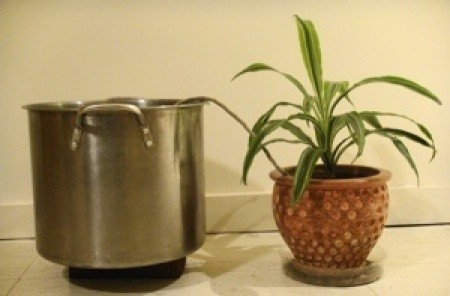From the simple to the extravagant, the garden marketplace is full of products that can feed and water your container plants for you. But if you prefer to spend your money on plants, rather than "systems," you may want to consider a simple and inexpensive method using wicks. If you're leaving home on vacation for a week or two, or you simply don't have the time to water dozens of containers every day, wick watering can be an efficient, do-it-yourself solution to keeping your container plants happy.
The theory behind wick watering is a simple one. A wick is run from the top of the pot down through a drainage hole and into a reservoir holding water. As soil in the pot dries out, capillary action from the wick draws water in from the reservoir and re-hydrates the plants. When the soil reaches it's moisture bearing capacity, the wick stops drawing water.
The best way to insert water wicks into your container plants is to "plant" the wick in the pot at the same time you're planting the container. The wick(s) should be long enough to reach from your water reservoir to the bottom of the pots. Excess cord can be coiled around the sides of the pot and hidden beneath the plant's foliage when you're not using it.
Arrange your pots closely around the water reservoir. Make sure your plants are watered normally (from the top) before starting the process. As the soil dries, water will be drawn into the pots through the wick.
A tray with a hole in the center, that allows the pot to rest of top of the reservoir.
This method works well for small, individual pots. It is commonly used to water small African violets. A shorter cord is placed in the bottom few inches of the container and run out the drainage hole. The pot is then set on top of a reservoir and the cord is allowed to dangle into the water and draw up the water as needed. If needed, fertilizer can also be added to the reservoir. This method works best for smaller plants because water will only travel about 4" up the wick.
Don't set off on your summer vacation before testing out the bugs in your wick watering system. Wicks can fail for several reasons:
Most gardeners find this system reliable for a week or more, but if you're leaving town, perform a trial run for at least as long as you're going to be gone.
Over time, wicking material will slowly get clogged with soil particles, algae, minerals, or fertilizer salts. Expect to change them every 6-8 months, which is also a good time to freshen up the soil in your containers.

About The Author: Ellen Brown is an environmental writer and photographer and the owner of Sustainable Media, an environmental media company that specializes in helping businesses and organizations promote eco-friendly products and services.
Add your voice! Click below to comment. ThriftyFun is powered by your wisdom!